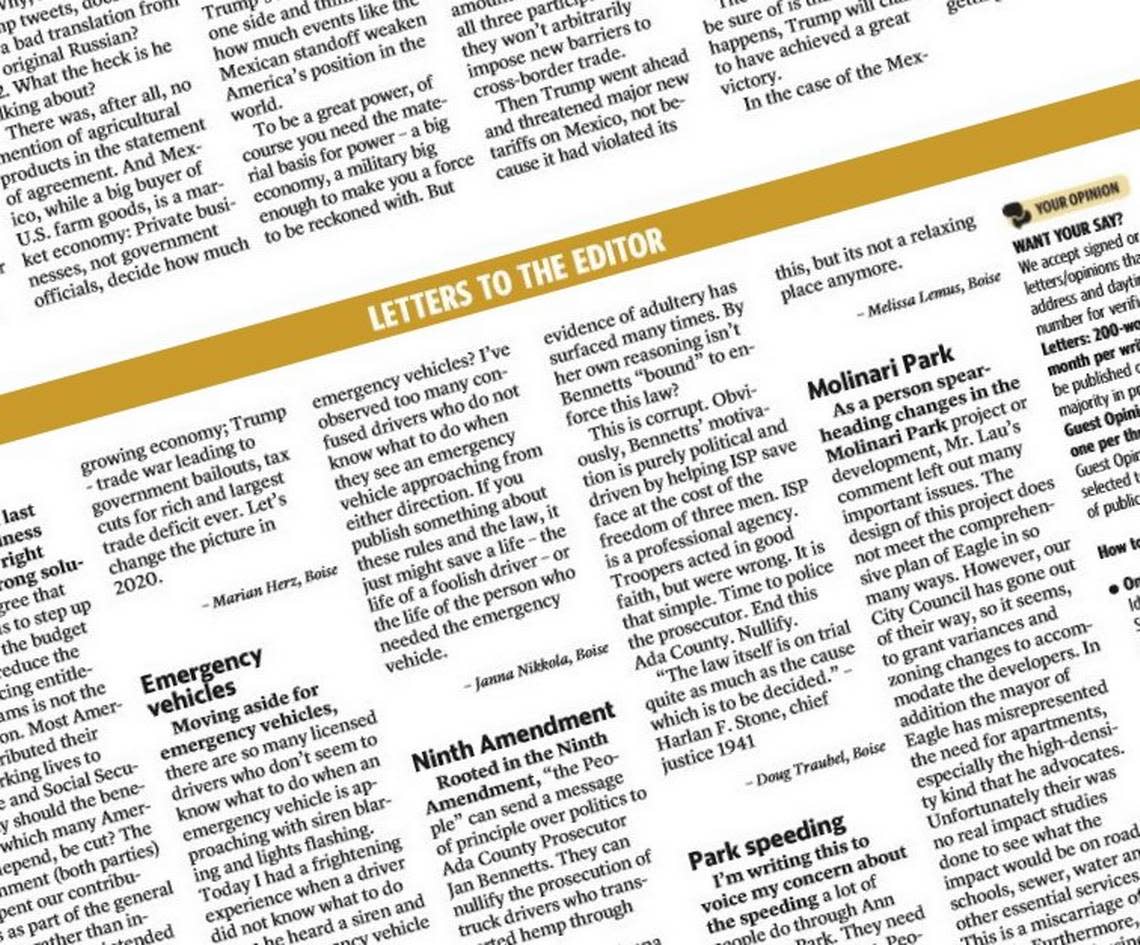Letters to the editor: Interfaith Sanctuary, Boise mall shooting, sewer bond, water woes

Interfaith Sanctuary
The conversation about Interfaith Sanctuary’s proposed moved to State Street has largely focused on the shelter’s fit within the community. Fit aside, I struggle with Interfaith’s new sign on State Street: “Have a little faith in Interfaith.” During last February’s meeting, local community members were left with the message that Interfaith was moving regardless of their concerns. Interfaith’s response to the local community’s concerns has largely been, “we’re just going to be really good neighbors.” More recently, the Shelter Better Task Force was asked to identify potential shelter sites for Interfaith, but instead opted to provide general best practices for emergency shelters, side-stepping an examination as to whether the State Street location was the best, or even an appropriate, location for the proposed shelter. This shift is understandable since the assignment was given after the fact. The task force’s final message: No shelter is “not an option.” Just weeks later, Interfaith declares that it will shut its doors if the conditional use permit is not approved. It feels disingenuous to be asking a community for “faith” when Interfaith forces the local community and the city into a no-win situation. All parties are entitled to a fair process, not an inevitable outcome.
Jeffrey Street, Boise
Boise shooting
In response to your editorial, “Idaho was never immune to mass shootings,” I’d like to make two points. First, according to the definition printed in another Statesman article, this is not considered a mass shooting. Second, it is simply false to claim we are at a “crisis point” with respect to mass shootings or “gun violence” or violence in general. In fact, homicide rates have steadily been going down for almost 30 years, with a slight uptick in the last year or so now that liberals have demonized law enforcement officers and normalized and condoned political mob violence. Idaho’s homicide rate is actually lower than most Canadian provinces. So please don’t print falsehoods in an attempt to further your support of big government and the erosion of individual liberties.
Mark Weaver, Kuna
Sewer bond
I wish I had written sooner. I just tried to vote on the sewer bond and was unable to, even though I’m a Boise resident. I live in the West Boise Sewer District. So I was ineligible to vote. West Boise Sewer District has a contract with the city to process waste water; thus, I may have to pay anyway. The issue though is that the cost of the new water treatment facility is about what the cost of the new downtown Library would have been. I don’t recall ever voting for the water treatment facility. While everyone may benefit from this construction, the issue is why didn’t I have a chance to vote on the cost and placement of this facility. It seems to me this is the exact reason McLean ran for office. Yet here we are confronting another done deal. I think I’d vote no (if I could) and then see what happens to the members of the city council when rates go up 50%.
Joe Gallagher, Boise
Water shortage
CBS’s 60 minutes just aired a segment, “ Not enough water to go around.” It’s online. Think Idaho Snake and Boise rivers; the reservoirs, aquifers and recharging areas.
Extending Eagle city water service increases water rights but also potential responsibility to provide and liabilities. New and deeper wells are then needed, affecting existing individual wells? It’s happened throughout the West. Huge increases in pipeline material, installation and energy costs for pumping, especially so for extended distances. The Idaho Department of Water Resources has already run into this as reported in an Idaho Farm Bureau Federation report. It’s worth reading all those publications. Rights don’t equal water, as seen in St. George, Utah, which grew 29% in a decade. Sound familiar? Also, from local news programs, struggles with aquifer, Anderson Ranch Reservoir and dried recharging captures in Elmore County, which is the “geologically same” Western Snake Plain aquifer, serving the Treasure Valley.
Environmental carrying capacity has to be addressed in terms of growth and water conservation. A plenitude of examples to heed. It can happen here, too. It is serious and needs all of our attention and action now and into the future for continued Idaho water availability.
Barb Jekel, Eagle

 Yahoo Movies
Yahoo Movies 
